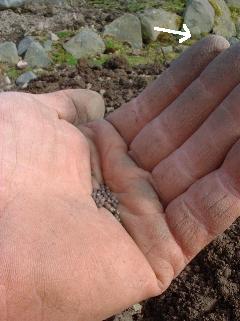Growing Vegetables
|
Growing vegetables is probably the most rewarding activity in the garden. By sowing a few seeds a great feast will be yours after a few weeks or months. The American polymath Thomas Jefferson said that he ate little meat and considered it "as a condiment for the vegetables, which constitute my principal diet". He grew over 250 cultivars of 70 species of vegetables in the garden on his plantation, Montecello at Charlottesville, Virginia (with the help of his slaves who did not enjoy "life, liberty, and the pursuit of happiness"!). When choosing the crops to grow, start with the ones you like - some have recently been labelled 'superfoods'. Start with something easy such as salad leaves. All you need is a piece of open, weed-free ground and just scatter the seed. After a few weeks they will be ready to eat. Most of the annual crops can be germinated and raised in trays to get a head start and reduce losses to pests when they are most vulnerable. Some should be sown directly as they do not like to be transplanted, particularly root vegetables such as carrots due to their single taproot. The recent development of Mycorrhizal fungi has given the grower another 'tool' for increasing the productivity of the vegetable plot. These beneficial organisms form a symbiotic relationship with the root system of plants, increasing the uptake of nutrients and water. They are applied at planting time and can transfer to following crops in a rotation, so the use of fungicidal agents would have to be avoided in order to maintain their presence. The current very variable weather can have a devastating effect on vegetable crops. The dry periods in spring reduces the germination of seed, then deluges of rain later causes some to rot away or they are smothered under flood water. Diseases can also be more prevalent with Mildew in dry periods and humid conditions when potatoes are maturing, cause an increase in Blight - commercial growers can be unable to get onto fields to use preventive sprays. Excess water can also cause splitting of root crops and fruit as the plant cells expand at a greater rate than the skins can cope with. It is a good idea to keep a record of the layout and the crops grown when operating a rotation system - it is easy to forget the location of previous crops. Also the particular Varieties can be recorded and can be grown again, or not, if they did not perform well or were not good to eat. The column on the right has links to monographs on some of the vegetables more commonly grown in the vegetable plot, pointing out growing tips and the pests and diseases which attack the crops. While some chemical treatments are mentioned they should be a last resort if they are to be used at all, and are included here for information. Many of the pests can be kept at bay using barriers such as fine netting or garden fleece, eg. Cabbage White Butterflies and Carrot Root Flies. Back to Down Garden Services
Use this button to file this page with your favourites
|
Use the links below for details on growing some crops:- Beans Beetroot Cabbage Carrots & Parsnips Courgette (Zucchini) Leeks Lettuce Onions Peas Potatoes Swede (Turnips) Grow Tasty Tomatoes Secrets to growing tomatoes, By a world authority who advises professional growers. Growing A Rose Garden Get your rose garden established and thriving |
